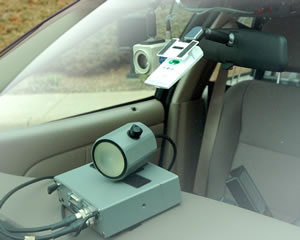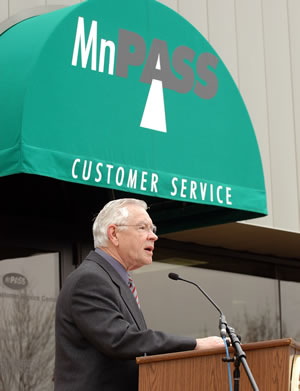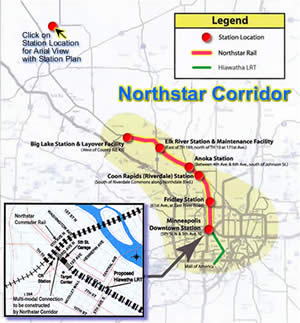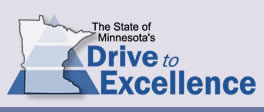 |
 |
|
 |
MnPASS Service Center opens, begins leasing transponders |
 |
 |
 |
|
The MnPASS system uses a small radio transmitter in each vehicle. The transponder communicates with overhead antennas to levy the tolls. Nearly 1,100 transponders were leased as of April 12. Service on the system begins May 16. Photo by David Gonzalez |
Mn/DOT entered a new era April 11 when it began taking applications from users who want to drive on the MnPASS I-394 Express Lane in the western Twin Cities area—and are willing to pay.
As of April 12, 1,071 transponders were leased to drivers who paid an initial deposit of at least $40 plus $1.50 per month to lease the transponders.
Lt. Gov./Commissioner Carol Molnau and Deputy Commissioner Doug Differt helped to cut the ribbon opening the MnPASS Service Center in Golden Valley. At that time, the service center began taking MnPASS applications on line, by phone and in person at the service center front desk.
“We are here today to start down a new path in Minnesota transportation history, the MnPASS era,” Molnau said at the service center opening. “The lane is one of only a handful of its type in the country. And, it is clearly the one with the most technology involved.”
The new MnPASS lane opens May 16. It is essentially a conversion of the high-occupancy vehicle lane to a high occupancy toll lane. The express lane will allow single-occupant vehicle drivers to choose to use the lane for a fee. Transit, carpools and motorcycles will continue to use the lane for free.
The lane has a prepaid electronic toll collection system that eliminates the need for toll booths. It uses a small radio transmitter, or transponder, in each vehicle that communicates with overhead antennas to levy the tolls.
 |
Deputy Commissioner Doug Differt provides a few remarks April 11 at the opening of the MnPASS Service Center in Golden Valley. Photo by David Gonzalez |
The system uses a dynamic pricing system that will vary the toll rate according to the amount of traffic in the toll lane. The toll will increase as the amount of traffic increases, but will average from $1 to $4 during rush hours to a maximum of $8. The fee is posted on overhead signs just before the entrances to the MnPASS lanes so drivers can choose whether or not to use the lane at that time for the specified amount.
The Minnesota State Patrol and other law enforcement officers will enforce the lane, with violators subject to significant fines.
“This project is unique in Minnesota in that we have joined forces with private partners to make this happen,” Molnau said. “These partnerships helped us find new directions and new ways to respond to the growing congestion in the Twin Cities metropolitan area.”
She said that lanes similar to the I-394 project are working well in California and Texas.
“We couldn’t have reached this point without the assistance provided by the members of the community task force,” Molnau said, referring to the 394 Community Task Force, a group of representatives from corridor communities.
“The task force met for many months and tackled a number of difficult issues. It helped us develop solid operating guidance, which should serve the lane well into the future.”
See also www.mnpass.org for more information.
By Kevin Gutknecht
|
back

|
 |
Capital investment bill includes $37.5 million for Northstar rail |
 |
 |
 |
|
The Northstar commuter rail project will receive $37.5 million as part of the $945 million capital investment bill the governor signed April 11. The signing took place at the Coon Rapids-Riverdale park-and-ride lot, future site of one of the stations on the Northstar line. Graphic courtesy of Passenger Rail Web site |
Nearly $100 million of the $945 million capital investment bill recently signed by the governor will go to support the Northstar commuter rail, local roads and bridges, and the Cedar Avenue (Hwy 77) bus rapid transit project in the Twin Cities metro area.
Gov. Tim Pawlenty signed the bill April 11 at the Coon Rapids-Riverdale park-and-ride lot, future site of one of the stations on the Northstar line. The Northstar commuter rail project will receive $37.5 million.
"After years of hard work by many it's time to get on board the Northstar line," Pawlenty said. "This is one of the fastest growing corridors in the country. We need to bring relief and more choices to commuters so they can spend more time the way they choose, rather than sitting in traffic. The Northstar commuter line is a congestion buster and we need it."
The capital investment bill also provides $40 million for local bridge replacement projects, including the Sauk Rapids bridge which will receive $15 million. Local roads will receive $10 million—$5 million for roads of regional or statewide significance and $5 million for rural road safety.
“Local governments are important partners with Mn/DOT as we build and maintain Minnesota’s roadways and bridges,” said Lt. Gov./Commissioner Carol Molnau. “It takes this strong partnership to ensure all systems are compatible across the state.”
Another $10 million is slated for the Cedar Avenue bus rapid transit project, which will go from the Mall of America in Bloomington to Lakeville in the southern Twin Cities metro area.
Funding for other significant transportation capital improvements include:
- $5.25 million for transit in the Twin Cities metro area central corridor
- $4.4 million for local road wetland mitigation
- $2.5 million rail service improvement program
- $2 million port development assistance
- $1 million St. Paul Downtown Airport Holman Field flood protection
- $1 million Duluth aerial lift bridge restoration
In all, the bonding package will provide funds for five key quality-of-life areas:
- Investments in Education - $322 million
- Jobs, Housing and Transportation - $204 million
- Safer Communities - $125 million
- Water, Environment and Natural Resources - $211 million
- Effective Government and Public Services - $83 million
See the Governor’s news release for more information.
|
back

|
 |
Governor lays out roadmap for state’s Drive to Excellence |
 |
 |
 |
|
The governor released the Drive to Excellence Transformation Roadmap on April 4, a document that sets a course for state agencies that aims to save taxpayers as much as $570 million by 2011. |
Creating easy access to services for citizens and businesses and streamlining government are among the goals of the governor’s plan to overhaul state government.
Released April 4, the Drive to Excellence Transformation Roadmap plots a course for state agencies that aims to save taxpayers as much as $570 million by 2011.
The first set of projects to be implemented, some of which will require legislative action, covers six areas:
-
Information technology. State agency information technology systems will be brought together and headed by a state chief information officer charged with central planning, development, operation and oversight. There will continue to be IT staff working in individual agencies. A bill is currently before the Legislature proposing changes to the state’s information technology governance.
-
Real property management. The state's 5,000 buildings and nearly six million acres of land are currently managed by 14 agencies. This project will coordinate real property management to optimize rent, repair, maintenance costs and ownership opportunities.
“In all, the Drive to Excellence plan outlines 24 initiatives,” said Mike Barnes, Office of Information Technology director and Mn/DOT’s lead on the project. “The first six initiatives were chosen because of the immediate improvements they offer or because they lay an organizational foundation for future initiatives.”
Barnes said that Mn/DOT staff will be participating as needed in each project.
For more information:
|
back

|
 |
Workshop focuses on environmentally responsible program delivery |
 |
 |
More than 240 participants explored ways to ensure prompt project delivery while protecting the environment at the 2005 Environmental Stewardship and Streamlining Workshop held March 23-24 in St. Paul.
The workshop was the second sponsored by Mn/DOT to help government agencies meet state and federal environmental regulations while effectively delivering highway and other transportation-related projects.
Workshop topics ranged from “river-friendly” highway design to wetlands management to linking the planning process with the requirements of the National Environmental Protection Act.
The event also included panel discussions and presentations by environmentalists and project managers from other state DOTs, the Federal Highway Administration and consulting firms.
“The workshop enables us to keep engineers, road designers and consultants current on environmental regulations as well as improve our day-to-day working relationships,” said Barbara Bauer, a program administrator with Environmental Services and chair of the workshop planning committee.
Participants also heard case study reports on the environmental aspects of rebuilding two highways—Hwy 1 near Ely in District 1 and Hwy 23 between Willmar and New London in District 8.
In addition to concerns about the physical environment, workshop leaders also addressed those that affect communities such as projects’ effects on parks and other recreational land use, historical and archaeologically significant resources and communities comprised of low-income people or people of color (see below).
“The workshops helped us all grasp better the complexity of the state’s inter-related environments,” Bauer said. “It helped demonstrate the value of the review processes whether the environment is a wetland, an animal community or a residential neighborhood.”
By Craig Wilkins
Participants review environmental justice process used in Worthington
Participants in one workshop session reviewed the environmental justice process used by District 7 when planning a Hwy 60 improvement project in Worthington. The federally mandated process seeks to ensure that impacts from highway projects do not fall disproportionately on areas populated by minority or low-income people.
The process was established by a presidential executive order in 1994.
Gerry Larson, Environmental Analysis Unit chief, said project plans always consider effects on poor and minority populations. He said, however, that a proposed highway project in Worthington was the first to directly affect a specific geographic area inhabited by people classified as minority and low-income.
Peter Harff, District 7 manager for the Hwy 60 project, and a consultant sponsored a door-to-door survey of residents of a primarily Latino and low-income trailer park in the city’s northeast section. A person fluent in both Spanish and English interviewed more than half of the park’s residents.
The survey, Harff said, found that most of the park’s residents supported the district’s position to widen the highway near the park rather than in a nearby area that would require demolishing a landmark restaurant and affect other businesses.
The district, Harff said, preferred the trailer park site because it is already impacted by a four-lane highway, a busy, two-lane county road and railroad tracks.
“Our survey results surprised us,” Harff said. “We found, for example, that residents didn’t mind moving from the park that’s within walking distance of a packing plant where many work because nearly all the employees drove.
“We also found that the residents did not object to moving out of the trailer park,” he said. “We found that our standard relocation and right-of-way process will meet the park residents’ needs.”
|
|
back

|
 |
Research partners create alliance to expand road research |
 |
 |
A new governance structure intended to widen collaboration in road research was created by Mn/DOT, the Center for Transportation Studies and industry representatives.
The new governance structure is known as the Transportation Engineering and Road Research Alliance or TERRA.
TERRA was developed at the request of Deputy Commissioner Doug Differt in order to develop a comprehensive research program on pavement, materials and other engineering challenges, such as issues related to cold climates.
CTS staffs the task force; Dick Stehr, Engineering Services Division director, serves as its co-chair with Fred Corrigan, an industry representative.
TERRA’s goals include broadening participation in road research, communicating research activities to various audiences, engaging stakeholders to discuss research findings and determining future research needs.
“Our vision,” Stehr said, “is that TERRA will become a dynamic partnership of government, industry and academia that advances innovations in road engineering and construction.”
For more information about TERRA, contact Dave Johnson, MnROAD manager, at 651/779-5681 or via GroupWise.
|
back

|
 |
Statewide sick leave program needs employee donations |
 |
 |
The state program that allows state workers to donate vacation leave to fellow employees who have used all of their leave time due to illness or caring for a spouse or dependent child now carries a very low fund balance.
Kris Valley, a personnel officer with the Department of Employee Relations, said the program needs donations because it has only enough funds to support currently enrolled employees through the next few pay periods.
By donating leave, employees allow those who have used all of their vacation and sick leave time to remain eligible for salary and health insurance benefits.
State employees may donate a total of 12 hours of vacation each year to one or more employees.
DOER administers the pooled donations for all participating state agencies. The general pool contains excess donations made to employees who no longer need them. These donations are then shared with those employees who do not receive enough individual donations to cover their absence, Valley said.
Valley said there are usually from 25 to 35 employees enrolled in the program at any one time.
The following Mn/DOT employees are current program recipients: Farideh Amiri, State Aid to Local Transportation; Robert Ecker and Jane Greiner, Metro District, and Randi Nunnink, District 3.
Donations must be made in the name of a specific employee or employees, Valley said. If an individual employee doesn’t receive enough donations, DOER uses the general pool to supplement their donations.
To donate leave time, employees may contact their business representative or visit the Business Services Section’s Web site.
By Craig Wilkins
|
back

|
 |
Cancer claims life of Bemidji’s Jerry Wendorf |
 |
 |
Jerome “Jerry” Wendorf, a building utilities mechanic at the Bemidji/District 2 headquarters, died April 11 of cancer. He was 65. Wendorf was ill with the disease for nearly a year before his death.
Funeral arrangements are pending.
Wendorf’s career with Mn/DOT started in 1991 at Crookston. He later transferred to the Bemidji district headquarters as the building’s electrician and mechanic.
Before joining Mn/DOT, Wendorf was employed as a welder in his hometown of Bertha.
Al Weibye, building supervisor at Detroit Lakes , said he first met Wendorf when they worked on building a new high school in Bertha in the 1970s.
“I was a plumber and he was an electrician and welder; he could do just anything mechanical or electrical,” he said.
Weibye also noted that Wendorf was an avid stock car racer and mechanic.
Dan Trickey, Wendorf’s supervisor, also said he was very skilled.
“Jerry was multi-talented; he knew building heating, mechanical and electrical systems,” he said. “He was also very likeable and remained calm and cool all the time.”
His survivors include his spouse, Patti Wendorf, three sons and two daughters.
|
back

|
 |
|
 |



